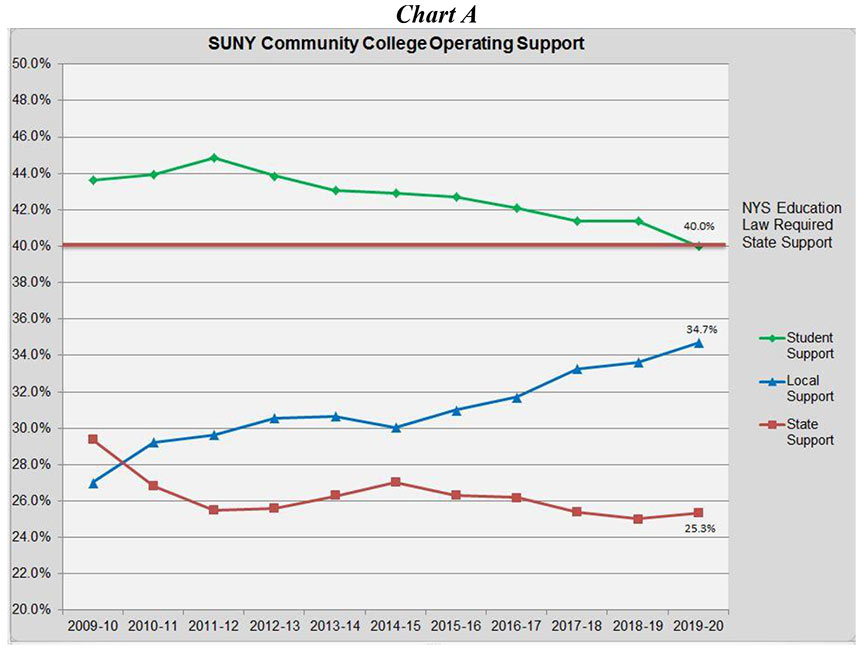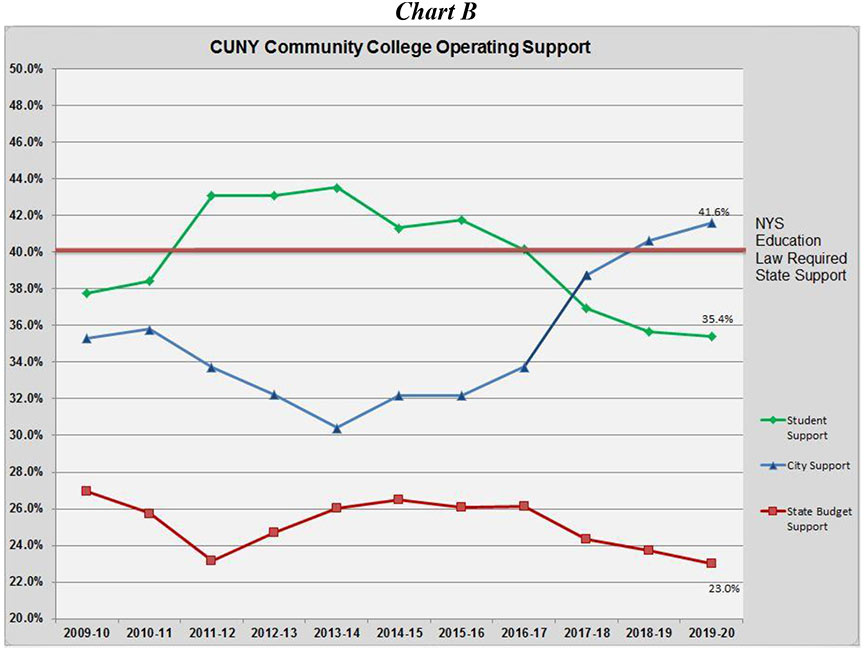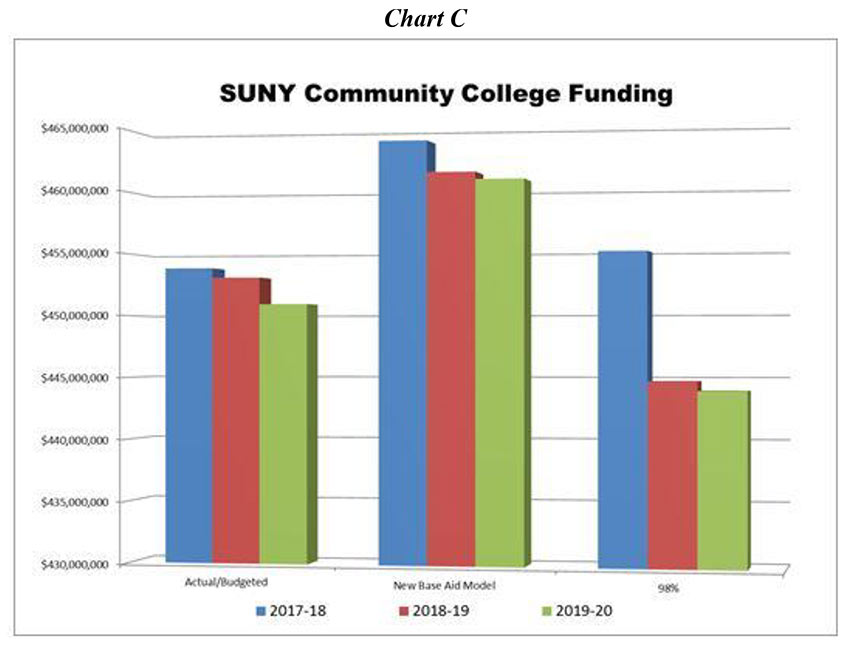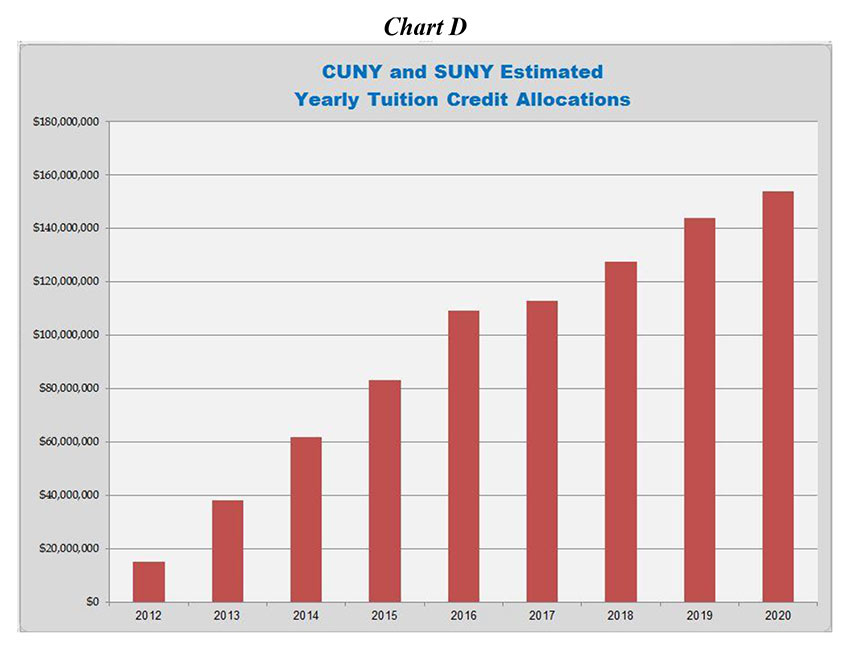Testimony of Andrew Pallotta, President, New York State United Teachers, to the Senate Finance Committee, Liz Krueger, Chair, and Assembly Ways and Means Committee, Helene Weinstein, Chair, on the Proposed 2020-21 Executive Budget for Higher Education. February 4, 2020.
Chairperson Krueger, Chairperson Weinstein, honorable members of the Legislature and distinguished staff, I am Andrew Pallotta, President of New York State United Teachers (NYSUT). NYSUT represents more than 600,000 teachers, school-related professionals, academic and professional faculty in higher education, professionals in education, in health care and retirees statewide.
Thank you for the opportunity to testify today on the proposed 2020-21 New York State Executive Budget for Higher Education. My testimony represents the concerns of over 80,000 faculty and professional staff who work in public colleges and universities across the state, as well as the three SUNY teaching hospitals. These include the members of United University Professions at the State University of New York, the Professional Staff Congress of the City University of New York and the faculty and staff at nearly all the SUNY community colleges in this state.
I am joined today by Dr. Frederick Kowal, President of United University Professions (UUP), and Dr. Barbara Bowen, President of the Professional Staff Congress (PSC). You will hear from both Dr. Kowal and Dr. Bowen in a few moments.
While we are grateful for the work the Legislature has done to restore funding to public higher education programs such as the opportunity programs, more is needed to reverse the impact caused by years of underfunding. This year, NYSUT is aggressively pursuing a campaign to secure stable revenue streams to fund the futures of our public higher education students. It is time to close the ever-widening gap between the haves and the have-nots. It is time to hold billionaires and ultra-millionaires accountable and demand they pay their fair share of taxes.
Sadly, educational inequality has become the most pressing issue of our time. Fully funding public education, from pre-K through college, is the only way to reverse this alarming trend. As I am sure you are all well aware, public higher education provides a pathway out of poverty for countless low-income families. The education our colleges and universities provide elevates our poorest New Yorkers to the middle class. When the state shirks its responsibility and fails to invest in our public institutions of higher learning it is harmful to our students and our communities. Worse still, these effects are most strongly felt in our low-income communities and the impact is borne by those who can least afford to shoulder it. Tuition increases of “only two hundred dollars” are not the solution and cannot continue as the new norm. For many people, two hundred dollars may mean the ability to pay for groceries and other necessities like heat, hot water and electricity.
Access to quality public higher education is a crucial component in the state’s efforts to recruit and retain businesses and industries. As businesses consider where to locate, they are drawn to locations with an available pool of highly trained and educated employees. The State University of New York (SUNY) and the City University of New York (CUNY) help to fulfill that requirement by instructing and preparing New Yorkers for current and future job opportunities. A growing number of employment opportunities require advanced degrees, which further underscores the need for greater state investment in public education. Properly funding CUNY and SUNY helps to ensure that all New Yorkers have access to an affordable, quality, public education.
State Investment
In recent years, we have seen a number of proposals put forth by the Legislature and the governor to increase student access to public higher education. The executive budget proposal seeks to once again expand access to the Excelsior Scholarship Program.
The executive budget holds SUNY’s and CUNY’s instructional core budgets flat from last year’s funding level. Unfortunately for our students, this has been the case for many years and needs to be addressed. While funding for instructional core budgets has remained flat, operational costs continue to rise. Without funding to address these operational costs, we are endangering student access to public higher education and the quality of the education they receive. A significant state investment is needed to reverse this trend and to preserve and enhance the quality of education received.
The current maintenance of effort (MOE) language in the education law was intended to shield the four-year colleges operated by SUNY and CUNY from year-to-year cuts and budget fluctuations. While the intent was laudable, the existing MOE, also known as the basic MOE, created a ceiling for funding rather than a floor. In the absence of a significant state investment in CUNY and SUNY, real growth and system-wide programmatic enhancements to the number of faculty, staff, programs and services students receive has been virtually non-existent. When we refer to an investment, we are asking the state to cover all mandatory costs, which include collective bargaining increases, energy and other inflationary costs as well as the tuition credit waiver. Without state funding to cover these rising costs, CUNY and SUNY are forced to absorb them, which often necessitates reductions in academic programs and student supports. We would like to thank the Legislature for continuing to support legislation that requires the state to reimburse all mandatory costs.
I know that my colleagues, Dr. Bowen and Dr. Kowal will speak to you about cuts to academic programs and student support centers drastically reducing their hours/student access due to a lack of funds. The impact of flat funding is being felt by many students across the state and is not anecdotal. It is also being felt by our members.
The myriad issues assailing our institutions of higher learning are a direct result of austerity budgets to our public university systems stemming back to 2011. NYSUT asks the Legislature to make operating aid for public higher education a priority in this year’s budget negotiations. You will hear more on this issue from Dr. Kowal and Dr. Bowen in a few moments.
Affordability and Accessibility
Over the years we have called for the hiring of much needed additional full-time faculty and staff at CUNY and SUNY. Additional faculty and staff are desperately needed to ensure that all students have timely access to advisement services and course offerings to assist them in completing their education on-time. Students should not have to delay graduation and incur additional debt because they took the wrong course or had to wait a semester or more for a required course to be offered.
With the implementation of the predictable tuition plan in 2011, tuition increases were supposed to be used to support an investment in classroom faculty, instruction initiatives to support on-time completion and the tuition credit. For years, NYSUT has argued that the students have paid more than their fair share through tuition increases, and it is time for the state to cover more of the costs. The executive budget seeks to extend the predictable tuition plan through 2025, authorizing SUNY and CUNY to raise tuition up to two hundred dollars per year. NYSUT has long advocated against tuition increases as a means to support our institutions. Raising tuition and cutting state funding is a recipe for disaster. The state needs to stop allowing SUNY and CUNY to raise tuition and minimize the impact it has on families by characterizing the increases as “only two hundred dollars.” It is high time for the people who pass these tuition hikes along to realize that while two hundred dollars may mean nothing to some, it means everything to others. The executive budget also provides for a two-to-one capital needs matching program. The executive budget does not specify what the funding will be used for or whether they will be foundation dollars or state operating dollars. At a time when state operating aid remains relatively flat campuses should not be forced to use state operating dollars to address their capital needs.
The state aid appropriation for CUNY and SUNY continues to include set-aside funding ($12M CUNY/$18M SUNY) with language to permit the systems to use the money to hire new classroom faculty. In prior years, this funding was intended for performance-based funding. NYSUT is pleased to see that the appropriation continues to allow the funding to be used for the hiring of new faculty, however, this funding is not sufficient. Due to years of flat funding, this set-aside is typically used by CUNY and SUNY for operational and programmatic needs and does not support adding needed faculty.
Community Colleges
At this time, I would like to discuss community colleges. I thank the Legislature for your continued efforts to support these campuses and your continued efforts to secure state base aid increases for community colleges. As you know, community colleges educate and prepare students for the workforce and provide the necessary foundation for students moving on to four-year campuses or universities. In addition to educating all types of students where they live and work, community colleges significantly advance social mobility. They often collaborate with regional businesses and employers to develop and provide training to address specific local workforce needs.
Notwithstanding the Legislature’s commitment to community colleges, state funding to these campuses is not commensurate with the provisions of the state education law. State education law provides that the state shall pay 40 percent of the operating costs of these campuses. As I am sure you are aware, the state is not remotely meeting this obligation.
As the attached Charts A and B illustrate, both SUNY and CUNY community college students are paying the lion’s share of operating costs of these campuses. Over the ten-year period from 2008-09 to 2018-19, SUNY community college students went from paying 40.8 percent of the operating costs to approximately 41.4 percent. While the state’s contribution for the same period decreased from 30.8 percent to 25 percent. We see a similar trend for CUNY community colleges during the same time period, where the student share increased from 32.3 percent to
40.6 percent, while the state share decreased from 28.9 percent to 23.7 percent.
The executive budget proposes flat funding per full-time equivalent (FTE) student for community colleges, which will likely force these campuses to raise tuition and/or eliminate programs and student services. While state base aid funding is flat, some of our community colleges will receive less state funding due to enrollment fluctuations.
In order for our campuses to maintain and enhance academic programming and supports, their state funding needs to be increased and stabilized. While enrollment on some campuses has decreased, operational costs have risen. As recently noted, SUNY community college enrollments have decreased across the board. We suspect the reductions in community college enrollments are related to an economy that is doing well and to a decrease in the state population, which is projected to continue.
Our campuses rely on state funding to offer programs and student services that not only respond to current and future business needs, but will also attract potential students. In the absence of predictable funding, campuses are forced to raise tuition and/or limit courses and programs, which diminish their appeal to future students and potential business partners.
NYSUT urges the Legislature to increase base aid by $250 per FTE student. This would raise the per student level of spending to $3,197 – this amount would greatly mitigate the impact of a loss of state aid due to enrolment fluctuations. We thank the Legislature for their historical support in restoring FTE funding to community colleges, and we believe now is the time to provide base line funding to financially stabilize our campuses.
The 2019-20 enacted budget provided community colleges with the greater of a $100 FTE increase or an established floor of 98 percent of the 2018-19 funding level. We appreciate the Legislature’s work and continued support in including this language, which is a good step to help address issues related to declining enrollment at community colleges. While this year’s enacted budget established a funding floor, unfortunately, it did not insulate all SUNY community college campuses from enrollment declines. A number of SUNY community college budgets will be lower than they were in 2017-18. While this year’s executive budget maintains the state base aid per FTE student, the overall base aid has decreased by $3.6 million due to lower enrollment. Additionally, the language that created the 98 percent floor was not included in this budget.
In addition to the aforementioned $250 per FTE student increase to base aid, NYSUT continues to advocate for the adoption of a hybrid FTE funding methodology, as proposed by SUNY for their community colleges. During budget negotiations last year, SUNY and NYSUT reached an agreement on statutory language to codify the hybrid methodology. The proposed hybrid methodology would provide SUNY community colleges with a greater of a level of support using a three-year average, or the FTE dollar amount for the college. This methodology change will provide our SUNY community colleges with some level of security and allow them to strategically plan for their future, as well as provide them with additional financial support, as outlined in the attached Chart C.
Tuition Assistance Program (TAP) Gap
Both SUNY and CUNY four-year campuses have been grappling with the growing tuition credit, which is an unfunded mandate that started in 2011 with the enactment of the tuition plan. All TAP students receive a tuition credit based on their income; with higher-income students receiving the lowest credit and lower-income students, who receive a maximum TAP award, getting the highest credit to fully cover the cost of their tuition.
As noted in the attached Chart D, you can see the rapidly rising cost of the TAP tuition credit, which now stands at nearly $150 million for both SUNY and CUNY and will grow to at least $170 million in 2020-21.
It is our understanding that a $200 tuition increase would cost each system an additional $10- 15 million. Campuses with high numbers of TAP students are penalized by the need to cover the TAP Gap without any state reimbursement. Existing law ensures that TAP students receiving a maximum award are made whole and provided access to CUNY and SUNY. Unfortunately, however, that access is compromised by the tuition credit. As noted above, the TAP Gap increases with every tuition increase, which is intended to cover the tuition credit along with other costs. Since the tuition credit has quickly grown over the years, institutions are left with less or very little money to invest in new faculty and other student initiatives to support on- time graduation.
When we have discussed the TAP Gap in the past, we focused on four-year campuses. Unfortunately, this is becoming an issue at five of SUNY’s Community Colleges (Clinton, FIT, Nassau, Orange and Suffolk) as tuition for the 2019-20 year exceeded the TAP limit of $5,165. We raise this issue because we expect this issue to impact additional campuses in 2020-2021. Since the law regarding the tuition credit only applies to four-year colleges, it is unclear who will be responsible for covering this difference at the community college level. If we use recent history as our guide, we strongly suspect that our colleges will be forced to bear the brunt of this latest fiscal challenge.
We thank Assemblymember Glick and Senator Stavisky for recognizing the importance of this issue and the financial and programmatic impact it has on campuses by introducing legislation (A.720/S.5293) to require the state to reimburse campuses for the tuition credit issued as a result of a tuition increase. While this legislation would not cover the full cost of the tuition credit, it would go a long way towards mitigating the current situation. NYSUT urges the governor and the legislature to provide SUNY and CUNY four-year and community college campuses with state reimbursement to cover the full cost of the TAP credit.
SUNY Hospitals
I would now like to talk about the SUNY hospitals. I want to thank the Legislature for its support and advocacy for the SUNY hospitals over the years. Unfortunately, the 2020-21 executive budget once again fails to restore the state subsidy to these hospitals. Not providing this critical subsidy jeopardizes the financial well-being of these hospitals and endangers access to health care for the communities that depend on them.
Over the years, the state subsidy to these hospitals has been reduced, from $90 million in SFY 2012-13 to $87.9 million in SFY 2017-18. As part of the 2018-19 New York State Executive Budget, the subsidy was eliminated. Working closely with the Legislature, we were able to secure federal funding in place of the state subsidy. Unfortunately, that funding was for one- year only. We ask the Legislature to restore funding to the 2017-18 level of $87.9 million.
The state subsidy is a vital source of funding to the hospitals and was first provided in 2001, in lieu of debt service and fringe benefits, which the state had covered many years ago. The three hospitals operated by SUNY are the state’s hospitals and, as such, the state should provide support to ensure their financial stability and viability, including funding to grow and expand the services needed to keep up with the various advances in health care.
In prior years, in order to keep within the global Medicaid cap, the state has reduced the state match. As the local sponsor for the three SUNY hospitals, the state has the financial obligation to provide the state match for these hospitals so that they can access federal DSH money for services provided to Medicaid and uninsured patients. As the state looks to reduce Medicaid
spending, SUNY hospitals have instead been forced to pay the state match. These facilities must identify funds they can use to cover DSH costs. These funds are often drawn from accounts that could be used to improve patient services, provide capital improvements or hire additional staff to address shortages. Therefore, by not providing the hospitals their share of the DSH, the state has compromised the financial viability and the capacity of these facilities to serve their patients and communities. We urge the governor and the Legislature to fully fund the state match for the three SUNY operated hospitals. In the absence of a state match, SUNY hospitals have and would once again be forced to cover the state match from their own operating funds.
The loss of the state subsidy is also compounded by the elimination of the Enhanced Safety Net Hospital Payments program. The Enhanced Safety Net program provided the SUNY hospitals with additional funding in recognition of their role in providing vital health care to the uninsured and under-insured.
NYSUT is also thankful for the inclusion of $150 million in the executive budget for capital funding to SUNY Upstate, SUNY Downstate and SUNY Stony Brook to be used for alterations and improvements.
You will hear more from Dr. Kowal regarding the impact of the enhanced MOE on the SUNY hospitals.
Student Financial Aid and Opportunity Programs
NYSUT was pleased to see the executive budget maintain funding for student opportunity programs that provide greater student access and remediation services for students in need. We also support updating the 40-year old Tuition Assistance Program (TAP). This program has afforded so many students in this state the ability to obtain a higher education; however, it needs to be updated. Too many students are now excluded from, or underserved by TAP.
Conclusion
New York State has taken steps to increase student access to public higher education. Now is the time to focus on preserving and enhancing the quality of the education offered by CUNY and SUNY.
We understand that the table target typically allotted to the higher education table is limited and does not allow for new investments after funding is restored to programs such as the student opportunity programs. However, we again call upon the Legislature to make higher education funding a priority this year and set-aside funding outside of the table targets to make a strong investment in the core instructional budgets of CUNY and SUNY. An investment is needed to reverse the impact of years of flat-funding and to ensure that we are providing our students the first-rate education they deserve.
Again, thank you for the opportunity to testify today. I will now turn it over to Dr. Kowal who will be followed by Dr. Bowen.
GA/AB/ARR 47911
1/29/20
Chart A

Chart B

Chart C

Chart D
